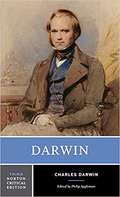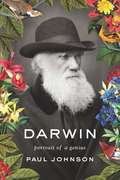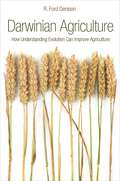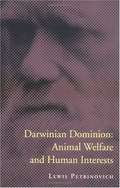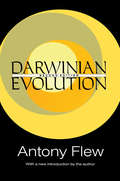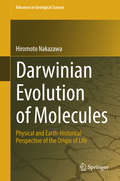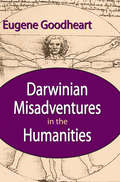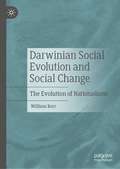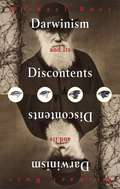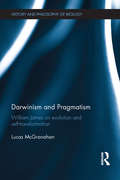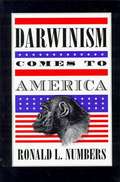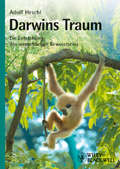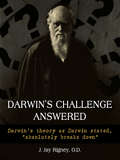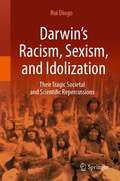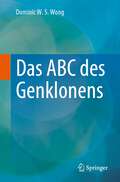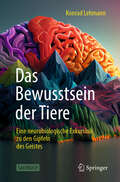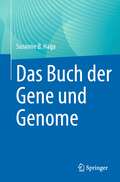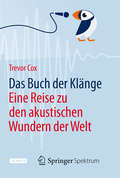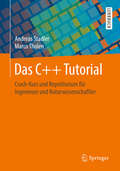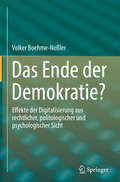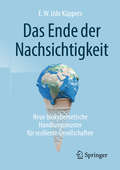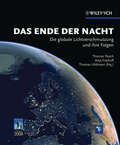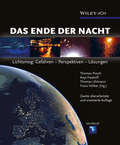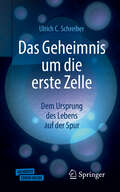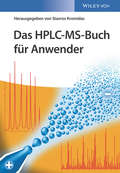- Table View
- List View
Darwin: Norton Critical Editions
by Philip Appleman<p>The impact of Charles Darwin’s work on Western civilization has been broad and deep. As much as anyone in the modern era, he changed human thought, and his influence is still felt in virtually all aspects of our lives. This new edition, larger and more varied than the previous ones, includes more of Darwin's own work and also presents the most recent research and scholarship on all aspects of Darwin’s legacy. The biological sciences, as well as social thought, philosophy, ethics, religion, and literature, have all been shaped and reshaped by evolutionary concepts. <p>Excerpts from the most important books and articles of recent years confirm this Darwinian heritage. New work by Richard Dawkins, Edward O. Wilson, Kevin Padian, Eugene C. Scott, Steven Pinker, Daniel Dennett, Michael Ruse, Frans de Waal, Noretta Koertge, George C. Williams, George Levine, Stephen Jay Gould, Gillian Beer, Ernst Mayr, and many others illuminates this exciting intellectual history. A wide-ranging new introduction by the editor provides context and coherence to this rich body of engaging material, much of which will be shaping human thought well into the new century.</p>
Darwin: portrait of a genius
by Paul JohnsonEminent historian Paul Johnson provides a rich, succinct portrait of Charles Darwin Charles Darwin is arguably the most influential scientist of all time. His Origin of Species forever changed our concept of the world’s creation. Darwin’s revolutionary career is the perfect vehicle for historian Paul Johnson. Marked by the insightful observation, spectacular wit, and highly readable prose for which Johnson is so well regarded, Darwin brings the gentleman-scientist and his times brilliantly into focus. From Darwin’s birth into great fortune to his voyage aboard the Beagle, to the long-delayed publication of his masterpiece, Johnson delves into what made this Victorian gentleman into a visionary scientist—and into the tragic flaws that later led Darwin to support the burgeoning eugenics movement. Johnson’s many admirers as well as history and science buffs will be grateful for this superb account of Darwin and the everlasting impact of his discoveries. .
Darwinian Agriculture: How Understanding Evolution Can Improve Agriculture
by R. Ford DenisonHarnessing evolution for more sustainable agricultureAs human populations grow and resources are depleted, agriculture will need to use land, water, and other resources more efficiently and without sacrificing long-term sustainability. Darwinian Agriculture presents an entirely new approach to these challenges, one that draws on the principles of evolution and natural selection.R. Ford Denison shows how both biotechnology and traditional plant breeding can use Darwinian insights to identify promising routes for crop genetic improvement and avoid costly dead ends. Denison explains why plant traits that have been genetically optimized by individual selection—such as photosynthesis and drought tolerance—are bad candidates for genetic improvement. Traits like plant height and leaf angle, which determine the collective performance of plant communities, offer more room for improvement. Agriculturalists can also benefit from more sophisticated comparisons among natural communities and from the study of wild species in the landscapes where they evolved.Darwinian Agriculture reveals why it is sometimes better to slow or even reverse evolutionary trends when they are inconsistent with our present goals, and how we can glean new ideas from natural selection's marvelous innovations in wild species.
Darwinian Dominion: Animal Welfare and Human Interests
by Lewis PetrinovichThe controversial subject of this book is the permissible use of animals by humans. Lewis Petrinovich argues that humans have a set of cognitive abilities, developing from a suite of emotional attachments, that make them unique among species.
Darwinian Evolution
by Antony FlewIn little more than a hundred years the evolutionary theory of Charles Darwin has conquered the thinking world. No other body of ideas has enjoyed such unrivaled success. But precisely because of its scientific status, Darwinism has sometimes been invoked to sustain other ideas and beliefs with a much less solid foundation. Darwinian Evolution is a study of the historical background of Darwin's ideas, of their logical structure, and of their alleged and actual implications.Flew explores the Scottish Enlightenment, an important and often neglected aspect of Darwin's intellectual background. He compares Darwin with such figures as Adam Smith, Thomas Malthus, and Karl Marx, emphasizing not the similarities, but the differences between the natural and social sciences. Flew argues that social science must do what natural science does not: take account of individual choice. He examines the creationist controversy in Britain and the United States and discusses the possibility of a human sociobiology.In his new introduction, Flew updates his book by discussing relevant works that have appeared since it was published thirteen years ago. He discusses two different tendencies among both social scientists and those who develop or promote social policies according to various findings in the social sciences: (1) to assume there is no such thing as human nature; and (2) to take no account of the possibility that differences between sets of individuals may be genetically determined. Flew maintains that both these tendencies violate Darwin's theory. Darwinian Evolution is an intriguing study that should be read by sociologists, biologists, philosophers, and all those interested in the impact of Darwin and his work.
Darwinian Evolution of Molecules: Physical and Earth-Historical Perspective of the Origin of Life (Advances in Geological Science)
by Hiromoto NakazawaOn the basis of thermodynamic considerations and the Earth’s historical processes, this book argues the physical inevitability of life’s generation and evolution, i.e., Why did life generate? Why does life evolve? Following an introduction to the problem, the hypothesis “Darwinian Evolution of Molecules” is proposed, which explains how, when, and where life was instigated through successive chemical reactions and the survival of selected molecules. The individual processes described are all scientifically reasonable, being verifiable by experiment. The hypothesis is supported by extensive reference to the scientific literature published in academic journals, including some experimental reports from the author’s own research group. The readers of this book will learn that the decreasing temperature of the early Earth led to a reduction in its entropy, inducing the Earth’s materials to order, which entailed ordering of the light elements as organic molecules with subsequent further ordering (i.e., evolution) to systems that can be considered alive (i.e., life). Researchers and students, as well as the non-academic audience, interested in the interdisciplinary problem of the origin of life will find suggestions and possible approaches to the scientific and conceptual problems they may be facing.
Darwinian Misadventures in the Humanities
by Eugene GoodheartIn recent decades the humanities have been in thrall to postmodern skepticism, while Darwinists, brimming with confidence in the genuine progress they have made in the sciences of biology and psychology, have set their sights on rescuing the humanities from the ravages of postmodernism. In this volume, Eugene Goodheart attacks the neo-Darwinist approach to the arts and articulates a powerful defense of humanist criticism. E. O. Wilson, the distinguished Harvard biologist, has spoken of converting philosophy into science, substituting science for religion, and formulating a biological theory of literature and the arts in Consilence: The Unity of Knowledge. Goodheart demonstrates that Wilson's efforts, and those of his colleagues Richard Dawkins, Steven Pinker, and Daniel Dennett among others, have resulted in scientism rather than science. If, for example, Dawkins had contented himself in The Selfish Gene with the claim that Darwinism had made worthless other answers to the question of how we have evolved, he would have given offense only to creationists, but questions of meaning and purpose are of another order. Contemporary Darwinist critiques err in assuming that art and traditional criticism aspire to truths that can be codified in terms of scientific laws. If this were so, we would have to regard the speculations of Plato, Aristotle, Augustine, Montaigne, Shakespeare, and Rousseau as worthless. Goodheart exposes the philistinism of literary Darwinism, the bad faith and inverted fundamentalism of the Darwinian approach to religion, and the dangers of the eff ort to create a Darwinian ethical system. Taken together, Goodheart's arguments show that in moving beyond their area of competence, the neo -Darwinists commit an ideology, not a science.
Darwinian Social Evolution and Social Change: The Evolution of Nationalisms
by William KerrThis book introduces the value of a Darwinian social evolutionary approach to understanding social change. The chapters discuss several different perspectives on social evolutionary theory, and go on to link these with comparative and historical sociological theory, and two case-studies. Kerr brings together social change theory and theories on nationalism, whilst also providing concrete examples of the theories at work. The book offers a vision of rapprochement between these different areas of theory and study, and to where this could lead future studies of comparative history and sociology. As such, it should be useful to scholars and students of nationalism and social change, sociologists, political scientist and historians.
Darwinism And Its Discontents
by Robert J. Richards Michael RusePresenting an ardent defence of Charles Darwin's theory of evolution, this book offers a clear and comprehensive exposition of Darwin's thinking. Michael Ruse brings the story up to date, examining the origins of life, the fossil record, and the mechanism of natural selection. Rival theories are explored, from punctuated equilibrium to human evolution (including the recently found 'hobbits', Homo floresiensis). The philosophical and religious implications of Darwinism are discussed, including a discussion of Creationism and its modern day offshoot, Intelligent Design Theory. Ruse draws upon the most recent discoveries, writing with a minimum of jargon in order to appeal to all readers, from professional biologists to those concerned that Darwinism is a naturalistic religion that is forced on school children despite their own Christian convictions. Openly revealing his own beliefs, Ruse presents readers with all the information and critical tools they need to make an informed decision on evolutionary theory.
Darwinism and Pragmatism: William James on Evolution and Self-Transformation (History and Philosophy of Biology)
by Lucas McGranahanCharles Darwin’s theory of natural selection challenges our very sense of belonging in the world. Unlike prior evolutionary theories, Darwinism construes species as mutable historical products of a blind process that serves no inherent purpose. It also represents a distinctly modern kind of fallible science that relies on statistical evidence and is not verifiable by simple laboratory experiments. What are human purpose and knowledge if humanity has no pre-given essence and science itself is our finite and fallible product? According to the Received Image of Darwinism, Darwin’s theory signals the triumph of mechanism and reductionism in all science. On this view, the individual virtually disappears at the intersection of (internal) genes and (external) environment. In contrast, William James creatively employs Darwinian concepts to support his core conviction that both knowledge and reality are in the making, with individuals as active participants. In promoting this Pragmatic Image of Darwinism, McGranahan provides a novel reading of James as a philosopher of self-transformation. Like his contemporary Nietzsche, James is concerned first and foremost with the structure and dynamics of the finite purposive individual. This timely volume is suitable for advanced undergraduate, postgraduate and postdoctoral researchers interested in the fields of history of philosophy, history and philosophy of science, history of psychology, American pragmatism and Darwinism.
Darwinism in America
by Ronald L. NumbersCompelling history of the legacy of Darwin's ideas in 19th and 20th century America.
Darwins Traum: Die Entstehung des menschlichen Bewusstseins
by Adolf HeschlNach seinem erfolgreichen Werk "Das intelligente Genom" befasst sich Adolf Heschl in seinem neuen Buch mit der Entstehung des Bewusstseins während der Evolutionsgeschichte. Unterhaltsam und leicht zugänglich geschrieben wartet der Autor nicht nur mit neuen Erkenntnissen aus der Primatenforschung auf, sondern verbindet sie mit Einsichten aus der Verhaltensforschung, Psychologie und Molekularbiologie. Insbesondere die Bedeutung des Lebensraumes der Primaten sowie der Anpassung an verschiedene ökologische Nischen für die Entwicklung des Bewusstseins und unseres Sozialverhaltens werden erläutert und der Autor kommt zu überraschenden Schlussfolgerungen, die ein neues Licht auch auf Theorien der Psychologie, wie die Freudsche Bewusstseinstheorie, werfen.
Darwin’s Challenge Answered: Darwin’s theory as Darwin stated, “absolutely breaks down”
by J. Jay Rigney, O.D.Darwin's book The Origin of Species was published in 1859. On page 159 of his book Darwin states, “If it could be demonstrated that any complex organ existed, which could not possibly have been formed by numerous, successive, slight modifications, my theory would absolutely break down”. This book directly, specifically, decisively answers Darwin's Challenge. As a result Darwin's theory as Darwin himself stated, "absolutely breaks down". Dr. Jan Jay Rigney graduated from Northeastern State University in Tahlequah, Oklahoma in 1984. At the time of the writing of this book, he will have been in private practice Optometry for thirty-one years. While practicing Optometry, he has had the opportunity to daily, for over 35 years, observe the design, function, and intricate interworkings of the human eye.
Darwin’s Racism, Sexism, and Idolization: Their Tragic Societal and Scientific Repercussions
by Rui DiogoIn this book Diogo, a renowned biologist and anthropologist, addresses a question that is critical for the understanding of science, beliefs, idolization, systemic racism and sexism, and our societies in general: why has Darwin been idolized in such a unique way, particularly by Western scholars? Diogo shows that many evolutionary 'facts' stated in Darwin's works, particularly about human evolution, are inaccurate constructions based on Victorian biases and stereotypes: non-Europeans are inferior, women have a lower intelligence than men, Victorian society was the pinnacle of evolution, and so on. Importantly, such inaccurate biased statements about our evolution are markedly in contrast with the mostly accurate, and often brilliant, ideas put forward by Darwin concerning non-human organisms. Importantly, it was precisely the combination of such brilliant ideas, the use of simplistic and sometimes exaggerated metaphors that were catchy and easily absorbed by the general public, and Darwin's intellectual conservatism and biased ideas about women and non-European peoples that led to Darwin's idolization, particularly by Western scientists, as well as to the darkest societal repercussions of his works. By portraying such biased ideas as “evolutionary facts”, Darwin provided easy ammunition for populist political leaders, authoritarians, colonialists, and white supremacists to 'scientifically' defend social hierarchies, sexism, racism, discrimination, oppression, and segregation. A typical argument used to defend Darwin from portraying such erroneous sexist and racist ideas as “facts” is that ‘back then’ everybody was racist and sexist. Diogo deconstructs this argument by providing enthralling case studies and travel descriptions by authors such as Wallace and Humboldt, who often praised the indigenous peoples that repulsed - and criticized the social hierarchies and Western imperialism that marveled - Darwin. The aim of this book is therefore not to 'cancel' Darwin orargue that he was always wrong: not at all, in general he was an extraordinary biologist, but was a much less successful anthropologist due in great part to his Victorian biases. Instead, the book discusses Darwin's writings, ideas, and their repercussions in a broader way, without taboos, omissions, idolization or demonization in order to show Darwin, and science in general, in all their complexity. This is because, if we fail to acknowledge and emphasize the biases, prejudices, inaccuracies, and abuses of our past, and merely continue to blindly idealize it, our kids will be condemned to undertake or suffer similar societal abuses in the future.
Das ABC des Genklonens
by Dominic W. WongDieses klare und übersichtliche Buch bietet einen Einführungskurs in die Sprache des Genklonens und deckt dabei mikrobielle, pflanzliche und Säugetiersysteme ab. Es stellt die Grundlagen des Genklonens in einer gut organisierten und zugänglichen Weise dar. Teil I dieses Buches umreißt die Grundlagen der Biologie und Genetik, die für das Konzept des Genklonens relevant sind. Teil II beschreibt gängige Techniken und Ansätze des Genklonens, angefangen von den grundlegenden Mechanismen der DNA-Manipulation, Vektorsystemen, Prozesstransformation bis hin zur Genanalyse. In Teil III und IV werden Anwendungstechnologien vorgestellt, die in der Landwirtschaft, Biomedizin und verwandten Bereichen von großer Bedeutung sind. Das ABC des Genklonens, dritte Auflage, enthält Aktualisierungen, darunter ein Tutorial-Kapitel über die Konstruktion von Genvektoren, Methoden zur Exom-Sequenzierung bei der Suche nach Krankheitsgenen, überarbeitete Themen zur Gentherapie und zur Ganzgenom-Sequenzierung, neue Entwicklungen zum Gen-Targeting und zur Genom-Editierung sowie den aktuellen Stand des Next Generation Sequencing. Mit mehr als 140 Abbildungen ist diese neue Ausgabe ein unschätzbarer Text für Studenten und alle, die die Sprache des Genklonens lesen und sprechen wollen.
Das Bewusstsein der Tiere: Eine neurobiologische Exkursion zu den Gipfeln des Geistes
by Konrad LehmannVögel zeigen Mitgefühl, Spinnen offenbaren sich als Individuen, Fische erkennen sich im Spiegel; laufend entdecken Neurobiologen und Verhaltensforscher bei diesen Tieren neue Fähigkeiten. Nicht nur der Mensch und seine nächsten Verwandten – wie man lange Zeit dachte – sondern auch Vögel, Cephalopoden, Insekten, Spinnen und sogar Fische haben komplexe Gehirne entwickelt, die ungeahnte geistige Leistungen ermöglichen. Mehrfach hat die Evolution der Nervensysteme beeindruckende Höhen erreicht. Der Reichtum der tierlichen Innenwelten erregt Staunen und eröffnet neue Blickwinkel auf die philosophischen Facetten von „Bewusstsein“.Inspiriert und geführt durch Jakob von Uexküll und seine „Streifzüge“ nimmt dieses Buch seine Leser mit auf eine Bergwanderung durch die Evolution der Nervensysteme, von den einfachsten Nervennetzen der Quallen bis zu den kompakten Denkorganen der höchstentwickelten Tiere. Sie begegnen dabei einer genialen Spinne, einem paffenden Delphinbaby, einem imagebewussten Fisch und einem Oktopus mit Albträumen. Herrliche Tierfotographien von ausgewiesenen Artenkennern unterstützen das Staunen über die Schönheit und Raffinesse der tierlichen Subjekte, mit denen wir uns den Planeten teilen.
Das Buch der Gene und Genome
by Susanne B. HagaDas Buch der Gene und Genome bietet einen prägnanten Überblick über die Fortschritte in der Genetik und Genomik und liefert den mit diesem Gebiet nicht vertrauten Leserinnen und Lesern eine knappe Beschreibung vieler Anwendungen und Auswirkungen in diesem Bereich. Angesichts der beträchtlichen Investitionen in Genetik und Genomik in den letzten Jahrzehnten und der vielen neuen Entdeckungen und Entwicklungen wird dieses Buch den Leserinnen und Lesern helfen, die Bedeutung von Genetik und Genomik für uns alle zu verstehen. Dieser spannende neue Titel enthält Informationen darüber, wie Genetik und Genomik unser Verständnis von Gesundheit und Medizin, Evolution und Biologie verbessert haben und wie sie die Grenzen von Ethik und sozialen Werten verschieben.Setzt keine Vorkenntnisse voraus; Leicht verständlicher Schreibstil, der es auch weniger erfahrenen Personen ermöglicht, die "Sprache" der Gene und Genome zu lesen und zu sprechen;Einbeziehung von Fallbeispielen, die zeigen, wie Gene und Genomik das Verständnis von Gesundheit, Medizin, Evolution und Biologie verbessert haben, aber auch Ethik und soziale Werte berücksichtigen;Empfohlene Lektüre, die das Selbststudium erleichtert; Klar und aktuell.
Das Buch der Klänge: Eine Reise zu den akustischen Wundern der Welt
by Trevor CoxMit dem Buch der Klänge führt uns der britische Wissenschaftler Trevor Cox in verborgene Hörwelten. Es weckt in uns das Verlangen, in einem Alltag, in dem das Visuelle so sehr dominiert, doch einmal genauer hinzuhören - und unsere Ohren für das wunderbare Klangdurcheinander um uns herum zu öffnen. Als Fachmann für technische Akustik hat sich Trevor Cox lange damit beschäftigt, unerwünschte Geräusche verschwinden zu lassen, ob Echos in Konzertsälen oder Lärm in Klassenzimmern. Eines Tages aber verschaffte ihm ein Ausflug in die Londoner Kanalisation ein erstaunliches Hörerlebnis - und die Erkenntnis: Statt seltsame Geräusche abzustellen, sollten wir die seltsamsten und bizarrsten akustischen Effekte zu schätzen lernen: als die Klangwunder unserer Erde. Das Buch der Klänge beschreibt seine Suche nach diesen Klangwundern. In der Mojave-Wüste besucht Cox singende Dünen. In Frankreich entdeckt er ein Echo, das zu Scherzen aufgelegt ist. In Kalifornien fährt er eine ,,singende" Straße entlang, die die Ouvertüre zu Wilhelm Tell erklingen lässt (wenn auch ziemlich schief). Und eine Entdeckung ist so beeindruckend, dass sie einen Eintrag ins Guinness-Buch der Rekorde verdient hat.
Das C++ Tutorial: Crash-kurs Und Repetitorium Für Ingenieure Und Naturwissenschaftler
by Andreas Stadler Marco TholenDieses Tutorial hilft nicht nur Ingenieuren und Naturwissenschaftlern beim schnellen Einstieg und der Vertiefung in die Programmierung mit C++. Kommentierte Aufgaben, lebensnahe Beispiele und eine kompakte sowie systematische Struktur zeichnen dieses Buch aus.
Das Ende der Demokratie?
by Volker Boehme-NeßlerWie verändert sich die Demokratie durch die Digitalisierung? Dieser Frage geht das Buch aus verfassungsrechtlicher, technikrechtlicher, politikwissenschaftlicher und psychologischer Sicht nach. Dazu arbeitet es zunächst die Charakteristika von Digitalisierung heraus. Es fragt, wie sich die Digitalisierung auf das Denken, das Verhalten und die (politische) Kommunikation auswirkt. Auf dieser Grundlage vertritt der Autor die These, dass sich die Demokratie grundlegend verändern muss und wird. Im letzten Teil skizziert er, wie die Demokratie konkret im digitalen Zeitalter funktionieren könnte.
Das Ende der Nachsichtigkeit: Neue biokybernetische Handlungsmuster für resiliente Gesellschaften
by E. W. KüppersDer Autor dieses Buches bespricht kleine adaptive Fortschritte, die ganzheitliches vernetztes Denken und Handeln voraussetzen, aus dem eine systemstabilisierende Wirkung erwächst. Biokybernetik und Deglobalisierung verfolgen ähnliche Prinzipien. Daher sind beide sehr geeignet, um das Metaziel Nachhaltigkeit zu stärken.
Das Ende der Nacht: Die globale Lichtverschmutzung und ihre Folgen
by Thomas Posch Anja Freyhoff Thomas Uhlmann Herausgegeben VonJedem Stadtbewohner fällt auf, dass wir nachts aufgrund immer heller werdender künstlicher Beleuchtung kaum mehr Sterne am Himmel sehen können. Doch dies ist nur die Spitze des Eisbergs, was den Verlust natürlicher nächtlicher Dunkelheit betrifft. Menschen und Tiere - darunter Nachtfalter, Zugvögel und Meeresschildkröten - leiden mittlerweile rund um den Globus an der Zerstörung des Tag-Nacht-Rhythmus durch die übermäßige Erhellung der Nacht. Beim Menschen können Krankheiten und eine Zunahme von Stress die Folgen sein. Das gesamte Phänomen, das bisher nur in Fachkreisen bekannt war, wird in diesem Werk erstmals umfassend und reichhaltig illustriert vorgestellt - von Experten aus Deutschland, der Schweiz, Österreich und den USA. Es ist für jeden geeignet, der sich für ein harmonisches Miteinander von Mensch und Natur sowie einen gesunden Arbeits- und Lebensrhythmus interessiert. Das Buch beruht auf der Fernsehdokumentation "The Dark Side of Light" von Anja Freyhoff und Thomas Uhlmann. Während der Dreharbeiten ist reichhaltiges und ungewöhnliches Bildmaterial entstanden, das die "dunkle Seite" des Lichts aussagekräftig illustriert.
Das Ende der Nacht: Lichtsmog: Gefahren - Perspektiven - Lösungen
by Thomas Posch Anja Freyhoff Thomas Uhlmann Franz HölkerEvery city dweller is aware that we are seeing fewer stars at night due to the increasing amount of artificial lighting. But that is just the tip of the iceberg, as far as the loss of natural nocturnal darkness is concerned. Humans and animals worldwide are now suffering from the disrupted rhythm of day and night due to extreme lighting at night. In humans this can lead to illness and increased stress. Hitherto only known to experts, this book is the first to comprehensively treat the entire phenomenon of light pollution. Richly illustrated using unusual images taken from the TV documentation "The Dark Side of Light" by Anja Freyhoff and Thomas Uhlmann, this book is for anyone interested in a harmonious coexistence between humans and nature and a healthy work/life rhythm.
Das Geheimnis um die erste Zelle: Dem Ursprung des Lebens auf der Spur
by Ulrich C. SchreiberEine der größten Fragen der Wissenschaft steht vielleicht in naher Zukunft vor der Aufklärung. Wie ist das Leben auf der Erde entstanden? Wo genau liegt der Ursprung? Welche Schritte waren von Nöten? Und wie hängen die komplexen Vorgänge zusammen?Zahlreiche Modelle wurden bereits beschrieben, die die grundlegenden Schritte für die Bildung organischer Moleküle auf der Erde oder im Weltall erklären. Doch scheiterten diese bisher daran tatsächlich plausible Szenarien für die entscheidenden Stufen der Lebensentwicklung daraus abzuleiten. Bei allen intensiven Überlegungen wurde ein Raum, ein Ort auf der Erde, übersehen, der eine Vielzahl an Möglichkeiten für die Entstehung der ersten Zelle bereithält. Mit einem Schlag scheint dieser Raum viele Probleme auf der Suche nach dem Ursprung des Lebens zu lösen. Es sind wassergefüllte Spalten, sogenannte Bruchzonen, in der kontinentalen Erdkruste, die alle Voraussetzungen für eine komplexe organische Chemie bieten. Der Autor nimmt seine Leser mit auf seine ganz persönliche Reise hin zur Antwort auf die vielleicht größte Frage der Biologie. So erklärt er nicht nur, wie die einzelnen Puzzleteile der Entwicklung des Lebens zusammen passen, sondern berichtet über seine persönlichen Erfahrungen in diesem schwierigen Forschungsfeld. Dabei zeigt er, dass erste Laborversuche unter realistischen Bedingungen eindrucksvoll eine chemische Evolution bestimmter organischer Moleküle bestätigen. Die Versuche sind an Prozesse angelehnt, wie sie von Beginn an in der tieferen Erdkruste stattgefunden haben. Zum ersten Mal legt der Autor seine Hypothese zur Speicherung genetischer Informationen in Form der RNA der breiten Öffentlichkeit vor. Finden Sie heraus, wie alles begann.
Das HPLC-MS-Buch für Anwender
by Stavros KromidasAus einem Verfahren für Spezialisten in der Forschung hat sich die LC/MS-Kopplung zu einer bewährten Routineanwendung entwickelt. Ziel des Buchs ist, LC/MS-Anwendern möglichst detaillierte Informationen zu geben, damit sie ihre LC/MS-Applikation optimal durchführen können. Nach einem Überblick über den gegenwärtigen Stand der Technik und instrumentelle Voraussetzungen werden Aspekte der Methodenentwicklung diskutiert. Ein Kapitel mit Tipps und Tricks leitet zu Anwenderberichte über, bei denen auch ein Blick über die klassische HPLC hinaus zur Ionenchromatographie geworfen wird. Berichte von renommierten Geräteherstellern über neueste Entwicklungen runden das Buch ab. Dieses Praktikerbuch liefert LC/MS-Anwendern die Informationen, die sie zur optimalen Nutzung ihrer Geräte benötigen: Von instrumentellen Voraussetzungen und Methodenentwicklung bis zu Anwender- und Herstellerberichten werden wichtige Themen kompakt auf den Punkt gebracht.
